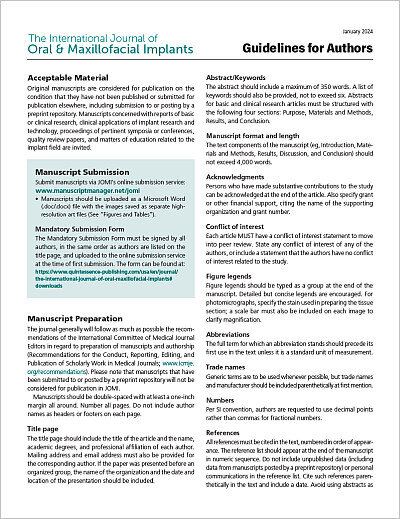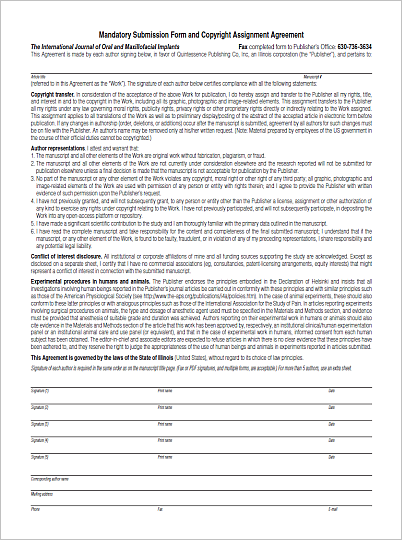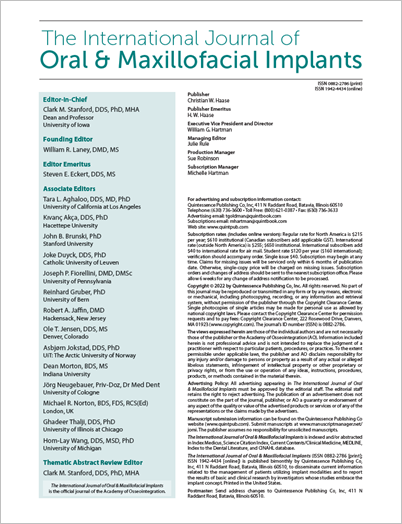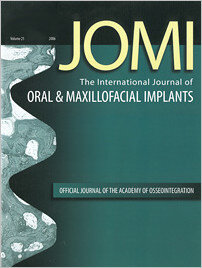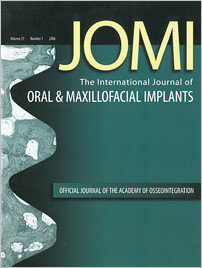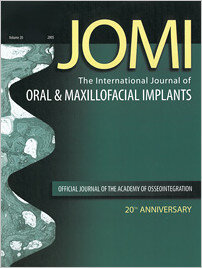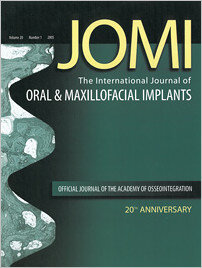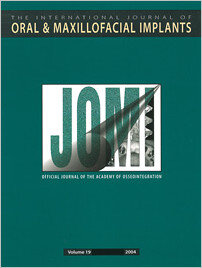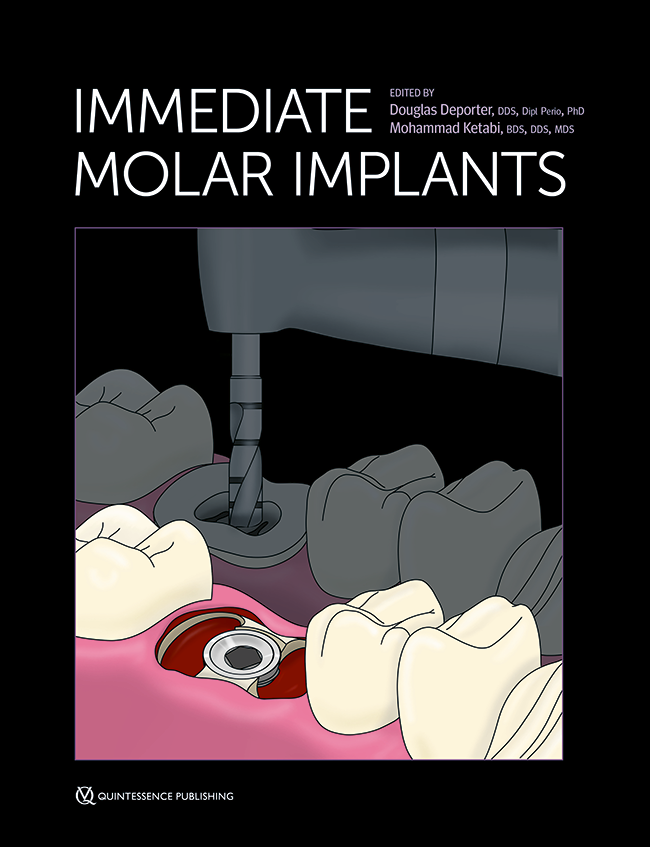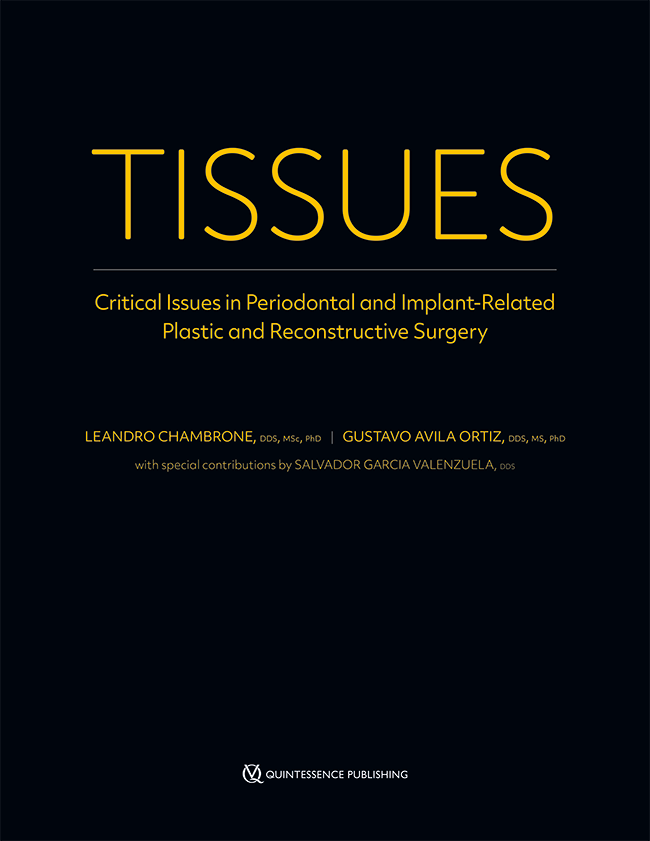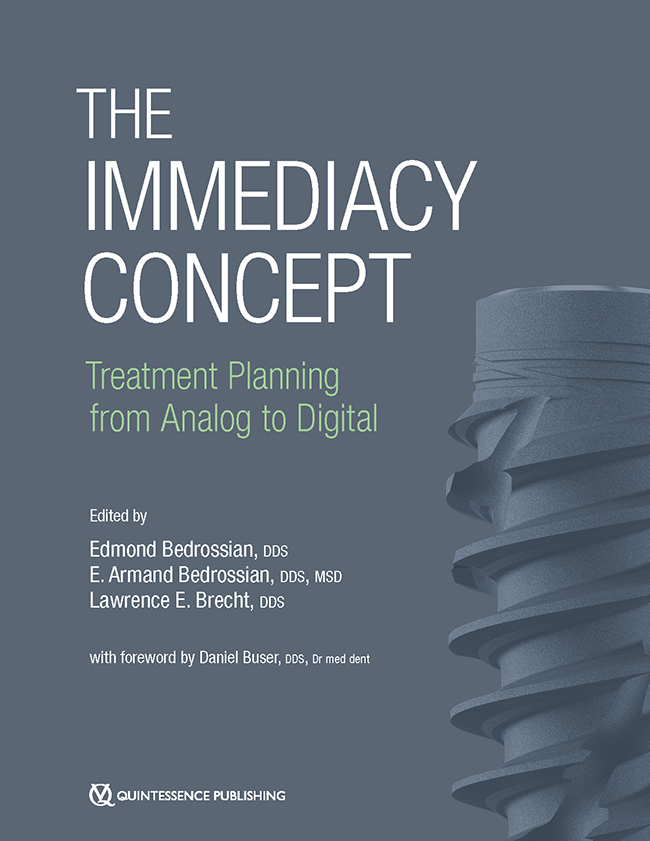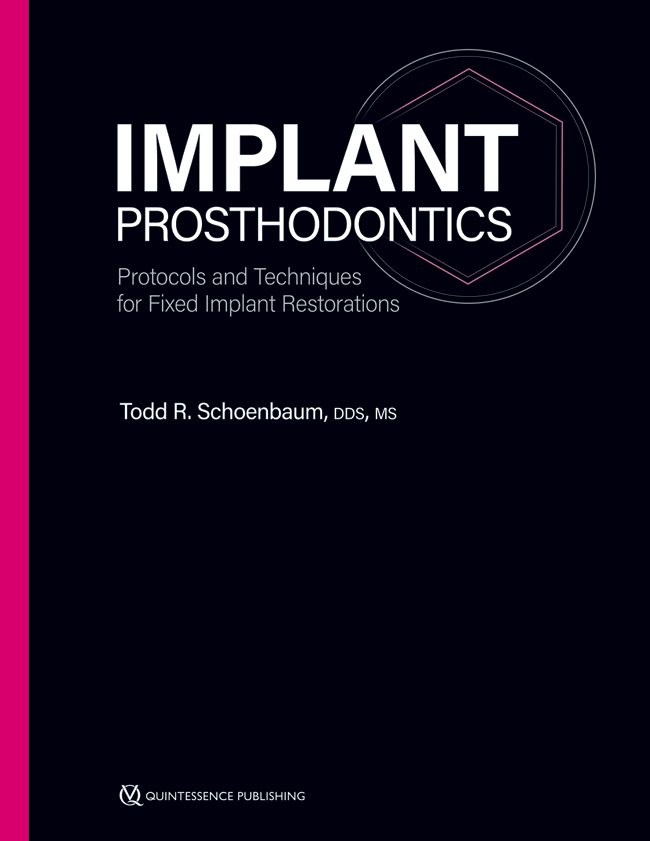ID de PubMed (PMID): 16955600Páginas 513, Idioma: InglésEckert, Steven E.ID de PubMed (PMID): 16955601Páginas 519-525, Idioma: InglésWolfart, Mona / Wolfart, Stefan / Kern, MatthiasPurpose: The purpose of this in vitro study was to evaluate the influence of cement type and application technique on seating discrepancies and retention forces of noble alloy castings cemented on titanium abutments.
Materials and Methods: Eugenol-free zinc oxide (Freegenol), zinc phosphate (Harvard), glass ionomer (KetacCem), polycarboxylate (Durelon), and self-adhesive resin (RelyX Unicem) cements were used. The inner surfaces of the castings were either completely coated or half-coated with cement. Abutments were used as delivered with a machined surface for the first part of the study. Groups of 8 castings were cemented in both ways. For the second part of the study, the abutments were air-abraded (aluminum oxide, 50 µm particle size), and groups of 8 completely coated castings were cemented with all cements. Marginal discrepancies were measured before and immediately after cementation. Tensile tests were conducted to measure the retention forces. Statistical analysis was performed with pair-wise comparison using the Wilcoxon rank sum test modified by Bonferroni-Holm.
Results: Change in seating discrepancies did not differ significantly among the different application techniques. The median retention forces for completely-coated castings were 177 N for eugenol-free zinc oxide, 346 N for zinc phosphate, 469 N for glass ionomer, 813 N for polycarboxylate, and 653 N for self-adhesive resin. With respect to retention force, 3 significantly different groups (P = .05) were identified: (1) zinc oxide, (2) zinc phosphate/glass ionomer, and (3) polycarboxylate/self-adhesive resin. No differences in retention between the 2 coating techniques were found for any cement. However, air abrading the abutments resulted in increased retention of the castings for some of the cements.
Conclusions: Half-coating of the restorations with cements did not result in reduced retention values compared to the complete coating technique, but air abrasion resulted in increased retention with some cements. (Basic Science)
Palabras clave: cement-retained prostheses, dental implants, fixed partial dentures, retention force, seating discrepancy
ID de PubMed (PMID): 16955602Páginas 526-534, Idioma: InglésChou, Ai Mei / Sae-Lim, Varawan / Hutmacher, Dietmar W. / Lim, Tit MengPurpose: This paper reports on a 2-phase study of a novel membrane-scaffold graft construct, its ability to support periodontal ligament fibroblast (PDLF) and alveolar osteoblast (AO) growth in vitro, and its use for tissue engineering a PDL-AO interface in vivo.
Materials and Methods: Human PDLFs were seeded onto perforated poly(e-caprolactone) membranes (n = 30) at 78,000 cells/cm2; human AOs were seeded on poly(e-caprolactone) scaffolds (n = 30) with fibrin glue at 625,000 cells/cm3. Cell attachment, morphology, viability, and metabolic activity were monitored for 3 weeks in vitro. Subsequently, cell-seeded membrane-scaffold constructs (experimental group, n = 9) and nonseeded constructs (control group, n = 4) assembled with fibrin glue were implanted subcutaneously into 7 athymic mice for 4 weeks.
Results: PDLFs formed confluent layers on membranes, whereas AOs produced mineralized matrices within scaffolds upon osteoinduction in vitro. Well-vascularized tissue formation was observed after implantation. Integration at the membrane-scaffold interface was enhanced in the experimental group. Type I collagen, type III collagen, fibronectin, and vitronectin were found adjacent to membranes and within constructs. Bone sialoprotein expression and bone formation were undetectable.
Discussion: Membrane perforation and scaffold porosity facilitated tissue integration and vascularization at the construct-recipient site. However, the interaction between PDLF and AO could have interfered with osteogenesis at the interface of soft and mineralizing tissues.
Conclusions: Both matrices supported PDLF and AO attachment and proliferation in vitro. The membrane-scaffold construct facilitated tissue growth and vascularization while providing strength and form in vivo.
Palabras clave: alveolar osteoblasts, graft construct, human periodontal ligament fibroblasts, poly (e-caprolactone)
ID de PubMed (PMID): 16955603Páginas 535-542, Idioma: InglésAghaloo, Tara L. / Le, Anh D. / Freymiller, Earl G. / Avera, Sean / Shimizu, Kenneth / Nishimura, Russell D.Purpose: The collection of autologous platelet-rich plasma (PRP) has demonstrated favorable affects on wound healing in compromised patients. The purpose of this study was to evaluate the expression of PDGF, bFGF, and TGF-b in irradiated and nonirradiated bone in a rabbit tibia model and the ability of PRP to increase growth factor expression when added to autogenous bone graft in a rabbit cranial defect model.
Materials and Methods: Ten New Zealand White rabbit tibiae and calvariae were utilized for this study. Tibiae were irradiated at 60 to 70 cGy and evaluated for expression of PDGF, bFGF, and TGF-b. Rabbit calvariae were also analyzed after grafting with autogenous bone and PRP for determination of growth factor expression.
Results: Decreased expression of PDGF, bFGF, and TGF-b was seen in cortical and cancellous bone samples when irradiated bone was compared to nonirradiated rabbit tibiae. An increase in PDGF, bFGF, and TGF-b expression was detected in cortical autogenous bone grafts with PRP at 1 and 2 months compared to autogenous bone alone.
Discussion: In this study, growth factors, which were decreased in irradiated cortical and cancellous bone, showed increased expression at 1 and 2 months when PRP was added to autogenous bone grafts. Thus, PRP may have potential therapeutic applications when bone grafting is required in patients with reduced bone vascularity, including patients with previous head and neck irradiation, diabetes, and smoking habits.
Conclusions: Decreased expression of PDGF, bFGF, and TGF-b was seen in radiated rabbit tibia as compared to nonirradiated controls, and increased expression of these growth factors was seen in PRP-containing autogenous bone grafts. (Basic Science) (More than 50 references)
Palabras clave: animal study, bone grafting, cranial defects, growth factors, immunohistochemistry
ID de PubMed (PMID): 16955604Páginas 543-550, Idioma: InglésLiskmann, Stanislav / Vihalemm, Tiiu / Salum, Olev / Zilmer, Kersti / Fischer, Krista / Zilmer, MihkelPurpose: The purpose of the present study was (1) to assess the relationship between clinical parameters and concentrations of the proinflammatory cytokine IL-6 and the anti-inflammatory cytokine IL-10 in the saliva of totally edentulous patients with implant-supported overdentures; (2) to assess whether estimation of IL-6 and IL-10 levels in saliva could be a useful laboratory tool to detect changes preceding serious clinical complications.
Materials and Methods: Thirty healthy adult volunteers (14 men and 16 women) with implant-supported overdentures were recruited from Tallinn Dental Clinic. The biochemical and clinical parameters evaluated were the levels of IL-6 and IL-10 in saliva, pocket probing depth (mm), Gingival Index (0,1, 2, or 3), and bleeding on probing (0 or 1).
Results: The level of IL-6 in saliva in the peri-implant disease group was significantly elevated compared to the healthy group. IL-10 could be detected only in the saliva of patients with peri-implant disease, and it did not appear at detectable amounts in saliva of healthy controls. In addition, the levels of IL-6 and IL-10 in peri-implant disease group were positively correlated with clinical parameters.
Conclusions: These data suggest that a significant relationship exists between the amount of a proinflammatory cytokine (IL-6) and the inflammatory response in peri-implant tissue. The results also suggest that IL-6 and IL-10 could be used as markers of peri-implant disease together and that the level of the latter cytokine gives additional information about the potency of an organism's integrated immune response for maintenance of inflammatory balance. (More than 50 references)
Palabras clave: dental implants, interleukin-6, interleukin-10, peri-implant disease, peri-implantitis, saliva
ID de PubMed (PMID): 16955605Páginas 551-559, Idioma: InglésPeleg, Michael / Garg, Arun K. / Mazor, ZivPurpose: Evidence suggests that smoking is detrimental to the survival of dental implants placed in grafted maxillary sinuses. Studies have shown that improving bone quantity and quality, using rough-surfaced implants, and practicing good oral hygiene may improve outcomes. In this prospective study, the long-term survival rates of implants placed simultaneously with sinus grafting in smokers and nonsmokers were compared.
Materials and Methods: Implants with roughened surfaces were immediately placed into maxillary sinus grafts in patients with 1 to 7 mm of residual bone. A total of 2,132 simultaneous implants were placed into the grafted sinuses of 226 smokers (627 implants) and 505 nonsmokers (1,505 implants). A majority of the patients received a composite graft consisting of 50% autogenous bone. In both smokers and nonsmokers, approximately two thirds of the implants had microtextured surfaces; the remainder had hydroxyapatite-coated surfaces. The implants were restored and monitored during clinical follow-up for up to 9 years.
Results: Cumulative survival of implants at 9 years was 97.9%. There were no statistically significant differences in implant failure rates between smokers and nonsmokers.
Discussion: Implant survival was believed to depend on the following aspects of the technique used: creation of a large buccal window to allow access to a large recipient site; use of composite grafts consisting of at least 50% autogenous bone; meticulous bone condensation; placement of long implants (ie, 15 mm); use of implants with hydroxyapatite-coated or microtextured surfaces; use of a membrane to cover the graft and implants; antibiotic use and strict oral hygiene; use of interim implants and restricted use of dentures; and adherence to a smoking cessation protocol. (Comparative Cohort Study)
Palabras clave: dental implants, sinus floor augmentation, smoking
ID de PubMed (PMID): 16955606Páginas 560-566, Idioma: InglésSakoh, Jun / Wahlmann, Ulrich / Stender, Elmar / Al-Nawas, Bilal / Wagner, WilfriedPurpose: The differences with respect to primary stability between 2 Camlog implants, a conical implant, and a hybrid cylindric screw-type implant, were investigated in vitro. The effect of under-dimensioned implant bed preparation was also studied for both implant designs.
Materials and Methods: In an in vitro model the stability of different implants in fresh porcine iliac bone blocks was measured using torque moment values, the Periotest, resonance frequency analysis, and push-out testing.
Results: The conical implant showed significantly higher primary stability than the cylindric hybrid implant using the insertion torque, Periotest, and push-out tests. For both types of implants, the torque moment values following under-dimensioned preparation were significantly better than those obtained following the standard drilling protocol (Conical: 25.00 vs 11.00 Ncm; Cylindrical: 11.75 vs 5.75 Ncm). For the cylindric implant, significantly better results following under-dimensioned implant bed preparation were observed only with the insertion torque and the pushout testing values. The mean ISQ values for all groups were between 55 and 57; no statistical differences with respect to ISQ could be found.
Conclusion: In this in vitro model conical implants showed higher primary stability than cylindric implants. The procedure of under-dimensioned drilling seemed to increase primary stability for both types of implants; however, the effect was only observable using insertion torque. RFA and Periotest, the noninvasive, clinical methods tested, did not clearly demonstrate this difference.
Palabras clave: bone condensing, conical implants, dental implants, primary stability, tapering angle of implants
ID de PubMed (PMID): 16955607Páginas 567-574, Idioma: InglésEliasson, Alf / Eriksson, Torbjörn / Johansson, Anders / Wennerberg, AnnPurpose: The purpose of this study was to evaluate and compare the long-term performance of fixed partial prostheses supported by 2 or 3 implants.
Materials and Methods: All patients treated with fixed partial prostheses supported by either 2 or 3 implants during the period 1985 to 1998 were included in this retrospective report. Annual clinical follow-up examinations were performed, with special attention to stability of the prostheses and peri-implant and occlusal conditions. Radiographic examination was performed when the prostheses were delivered (year 0) and subsequently at 1-year, 5-year, and 10-year examinations.
Results: A total of 178 patients had received fixed partial prostheses (FPPs) during this period of whom 123 (77 women and 46 men) were available for follow-up (mean age = 65 years, range 32-91). These 123 patients received a total of 146 implant-supported FPPs (63 two-implant- and 83 three-implant-supported) supported by 375 implants. The mean observation periods for the 2- and 3-implant-supported restorations were 9.6 years and 9.4 years (range, 5 to 18 years), respectively. Survival rates for the 2- and 3-implant-supported prostheses were 96.8% and 97.6%, respectively. The implant survival rate after loading was 98.4% for both groups. The mean bone loss at the 5-year follow-up was 0.3 mm for the 2 groups. No significant differences in bone loss (P > .05), implant failure rate (P > .05), or incidence of mechanical complications (P > .05) were found between the 2 prosthesis designs. The complications differed, significantly, with more loose gold and abutment screws in the 2-implant-supported group (P .05) and more porcelain fractures in the 3-implant-supported group (P .05).
Conclusion: The 2-implant-supported partial prostheses exhibited long-term clinical performance comparable to prostheses supported by 3 implants. (Comparative Cohort Study)
Palabras clave: complications, dental implants, dental prostheses, partially edentulous, retrospective studies
ID de PubMed (PMID): 16955608Páginas 575-580, Idioma: InglésVigolo, Paolo / Fonzi, Fulvio / Majzoub, Zeina / Cordioli, GiampieroPurpose: The purpose of this study was to assess the precision at the implant interface of titanium, zirconia, and alumina Procera abutments with a hexagonal connection for single-tooth restorations.
Materials and Methods: Twenty Procera abutments were produced with commercially pure titanium, 20 with zirconia, and 20 with alumina using computer-assisted design and manufacture (CAD/CAM). The rotational freedom of the abutments was assessed to detect the precision of fit of each abutment on the top of the implant hexagon.
Results: Significant differences relative to rotational freedom were found between groups: the titanium group and the zirconia group did not differ significantly, but both demonstrated significantly smaller mean rotational freedoms than the alumina group (P .05). Rotational freedom was less than 3 degrees for all abutments.
Conclusions: The hexagonal misfit of the Procera abutment on the implant hexagon may be implicated in screw joint loosening. In the present study, all types of CAD/CAM Procera abutments consistently showed less than 3 degrees of rotational freedom in a situation where the abutment was connected to an implant by a hexagonal external connection.
Palabras clave: abutments, hexagonal connections, single-implant restorations
ID de PubMed (PMID): 16955609Páginas 581-586, Idioma: InglésVandewalle, Giovani / Liang, Xin / Jacobs, Reinhilde / Lambrichts, IvoPurpose: To determine the incidence, size, location, course, and content of the superior genial spinal foramen and its bony canal.
Materials and Methods: Three hundred eighty dry human cadaver mandibles were morphometrically analyzed by measuring the distance from the foramen to the mandibular base and the size of the foramen and bony canal. Radiologically, the course of the bony canal and its relation to the mandibular incisive canal were investigated after injecting contrast medium (Omnipaque) in the superior genial spinal foramen and the incisive canal at the level of the mental foramen or by inserting a thin metal wire into the bony canal. Dissection was performed on another 10 intact cadaver mandibles.
Results: A distinct foramen was present in 98% of all dry specimens studied. Its general form was round or flattened funnel-shaped. Upon microanatomic dissection, a distinct branch of the lingual artery and the lingual nerve entering the superior genial spinal foramen were found.
Conclusions: The superior genial spinal foramen is present in most human mandibles and appears to be the entrance of a true lingual neurovascular bundle passing into the bone via a well-defined bony canal toward the buccal side. This implies that surgery and more specifically implant placement at the mandibular midline may carry some risk of neurovascular damage. (Basic Science)
Palabras clave: alveolar osteoblasts, graft construct, human periodontal ligament fibroblasts, poly (e-caprolactone)
ID de PubMed (PMID): 16955610Páginas 587-592, Idioma: InglésPan, Yu-Hwa / Ramp, Lance C. / Lin, Ching-Kai / Liu, Perng-RuPurpose: To determine the cement bond strength and marginal leakage of castings cemented to implant abutments.
Materials and Methods: Fifty-six titanium abutments and castings were divided into 7 groups (n = 8), 1 for each cement. Castings were cemented to abutments using 1 of 3 resin-based cements (RES, RES-B, and RES-B-P), a resin-modified glass ionomer (GI), a polycarboxylate cement (PCB), an acrylic urethane cement (UDM), or a zinc phosphate cement (ZP). Specimens were placed in 100% humidity at 37°C for 24 hours. Specimens were subjected to compressive load cycling followed by thermal cycling; they were then immersed for 24 hours in 0.5% basic fuchsin. Castings were removed with an Instron universal testing machine with a crosshead speed of 0.125 cm/min. Leakage was visually graded from 0 (no leakage) to 2 (leakage extended beyond the lower half of the internal surface of the casting). Failure load (FL) was analyzed with analysis of variance and Scheffe's test (a = .05). Chi-square was used to analyze leakage (a = .05).
Results: Cements were categorized by FL into 4 statistically unique groups: (1) RES-B-P (351 N) and GI (337 N); (2) ZP (245 N) and RES-B (241 N); (3) PCB (107 N); and (4) RES (63 N) and UDM (55 N). Leakage was greater for the PCB group than for the other groups (7 of 8 specimens demonstrated leakage; P .01). Three ZP specimens demonstrated leakage. UDM and RES each had 1 specimen with leakage. RES-B-P, RES-B, and GI showed no leakage.
Conclusions: Luting agents designated by the manufacturer as provisional cements demonstrated lower resistance to removal, regardless of material type. Luting agents described by manufacturers as "permanent" differed in resistance, with resin cements being most resistant, followed by zinc phosphate and polycarboxylate cements. Provisional cements demonstrated leakage comparable to higher-strength materials.
Palabras clave: abutments, hexagonal connections, single-implant restorations
ID de PubMed (PMID): 16955611Páginas 593-599, Idioma: InglésGanz, Scott D. / Desai, Nainesh / Weiner, SaulPurpose: Current implant systems with screw-retained abutments permit direct laboratory fabrication of castings. Computer aided drafting systems further enhance the fabrication of computer-milled abutments (CMAs) and castings. The purpose of this study was to compare marginal accuracy, as measured by gap size, of castings made directly on CMAs with those made indirectly on epoxy and stone dies.
Materials and Methods: Castings were made directly for 10 CMAs. Marginal gap measurements were made with the castings seated on the abutments (group A). Castings were also made indirectly on stone and epoxy dies obtained from impressions of the abutments. Marginal gap measurements were made with these indirectly made castings seated on their CMAs (groups B and E). In addition, the directly made castings were transferred between CMAs and marginal gap measurements made (group D). Marginal gap measurements of the groups were compared with analysis of variance (ANOVA) and pair-wise comparisons (Scheffé test).
Results: Groups A and D had marginal gaps of less than 100 µm. These marginal gaps were significantly smaller (P .05) than the gaps of groups B and E, made on dies, which were approximately 200 to 500 µm. Discussion and
Conclusions: With CMAs, it is possible to make an exact duplicate of the abutment. This permits the laboratory to make castings on duplicate abutments with greater precision than can be obtained using the indirect technique. Direct fabrication of castings resulted in smaller marginal gaps, which in turn allows a better marginal seal and improved retention of castings.
ID de PubMed (PMID): 16955612Páginas 600-606, Idioma: InglésMerli, Mauro / Migani, Massimo / Bernardelli, Francesco / Esposito, MarcoPurpose: To compare retrospectively the efficacy of and complications associated with 2 different techniques for vertical bone augmentation at implant placement: autogenous particulated bone grafts covered either by nonresorbable titanium-reinforced e-PTFE barriers or by resorbable collagen barriers supported by osteosynthesis plates.
Materials and Methods: Nineteen partially edentulous patients were consecutively treated: 11 patients had 18 implants treated for vertical bone augmentation with nonresorbable barriers, whereas 8 patients had 11 implants treated with resorbable barriers supported by osteosynthesis plates. Two independent assessors evaluated the amount of tissue regenerated and complications based on photographs and/or radiographs.
Results: No implants failed. In the group treated with nonresorbable barriers, complete bone regeneration was obtained for 12 of 18 implants. More than 50% of the planned regeneration was obtained for the remaining 6 implants. One patient had a dehiscence with suppuration that required an additional surgical intervention to remove the barrier. For resorbable barriers, complete regeneration was obtained for 10 of 11 implants. Dehiscences occurred in 2 patients. In 1 case no treatment was necessary. The other patient was treated with applications of chlorhexidine gel; more than 50% of the desired bone regeneration was obtained. Discussion and
Conclusions: No statistically significant differences for the amount of regenerated tissue and complications were observed between the 2 techniques; however, the power of the study was too low to detect a difference, if any. Randomized clinical trials with a sufficient number of patients are needed to determine which could be the most effective technique for vertical ridge augmentation.
Palabras clave: bone augmentation, bone grafting, dental implants, guided bone regeneration
ID de PubMed (PMID): 16955613Páginas 607-614, Idioma: InglésMundt, Torsten / Mack, Florian / Schwahn, Christian / Biffar, ReinerPurpose: The aims of this study were to examine the long-term survival and the prosthetic treatment outcome of screw-type, tapered implants placed in a private practice setting and to explore potential risk factors of implant failures.
Materials and Methods: In this retrospective analysis of patients treated with endosseous screw-type tapered implants, data relative to implant placement and failure, implant length, location, prosthetic treatment, medical history, smoking habits, and oral health behavior were gathered by chart review and questionnaire. An oral examination was also conducted. Cumulative survival rates were estimated through Kaplan-Meier methods. Comparisons between subgroups of patients were made using the log-rank statistical test. The association between several factors and implant failures was analyzed using Cox regression analyses (random and dependent models). Differences were considered significant when P .05.
Results: The survival rate of 663 implants placed in 159 patients (65 men, 94 women; 80.7% of 197 eligible patients) was 91.8% after 120 months. Mandibular implants had a higher survival rate than maxillary implants (96% versus 89%, P = .011). The failure rates for implants were 15.0% among current smokers, 9.6% among former smokers, and 3.6% among nonsmokers. The differences between nonsmokers, former smokers, and current smokers were significant (nonsmokers versus former smokers: P = .036, nonsmokers versus current smokers: P .001, former smokers versus current smokers: P = .003). Only number of years of smoking was significantly associated with an increased risk of implant failures (P = .036 using dependent estimation; P = .004 using independent estimation). The HR increased to 6.6 for patients who had smoked for 45 years. Loosening of prosthetic components were rare (n = 12). No fractures of screws or implants were found.
Discussion: Higher failure rates for former smokers and a dose-response effect between duration of smoking and implant failure rates suggested that permanent tissue damage from smoking may occur in addition to immediate local and systemic effects. The frequency of prosthetic complications was comparable to other studies.
Conclusions: Screw-type tapered implants placed in a private dental office demonstrated a cumulative survival rate of 91.8%. The relative risk of implant failure increased with the duration of smoking.
Palabras clave: dental implants, implant failure, life table analysis, smoking, survival rate
ID de PubMed (PMID): 16955614Páginas 615-622, Idioma: Inglésde Vasconcellos, Diego Klee / Bottino, Marco Antonio / Saad, Paulo Abdala / Faloppa, FlávioPurpose: This article reports preliminary clinical results of the Speed Master system, a method for immediate loading of implants for the treatment of mandibular edentulism.
Materials and Methods: Fifteen patients with edentulous mandibles were consecutively included in the study. Each received 4 implants between the mental foramina placed using the system's surgical guides. Permanent fixed prostheses fabricated over premanufactured titanium bars were attached to the implants on the day of implant placement. The patients were followed for 15 to 27 months (mean, 19 months). Peri-implant tissues were periodically evaluated. Marginal bone loss was monitored with periapical radiographs using a computerized technique. Satisfaction was assessed by means of a questionnaire.
Results: The overall implant and prosthetic survival rates were 100%. At the time of the final follow-up visit, mean marginal bone loss was 1.11 mm, and bleeding on probing was not observed. Only 6.7% of the patients reported any discomfort during treatment, and all patients would recommend the procedure to others.
Discussion: The immediate loading of implants placed in the edentulous mandible with the Speed Master surgical and prosthetic protocol reduces treatment time and number of surgical procedures in comparison to classic delayed loading protocols.
Conclusion: The rehabilitation of the mandible with an immediately delivered occlusally loaded hybrid prosthesis supported by 4 implants does not appear to jeopardize the success of the osseointegration and represents a viable treatment option.
Palabras clave: edentulous, immediately loaded fixed prostheses, immediately loaded implants, mandibular implants, single-stage implant placement
ID de PubMed (PMID): 16955615Páginas 623-628, Idioma: InglésHoffmann, Oliver / Suh, Young-il / Caruso, JosephPurpose: The aim of this report was to describe the initial 8-month healing events of 8 consecutive cases of placement of an onplant device for orthodontic anchorage and to report the results of a questionnaire evaluating subjective patient experience. Methods: At 2 weeks and at 4 and 8 months after placement of the device, presence or absence of exposure of the device, mobility using gentle finger palpation, and signs of possible inflammation were evaluated. At 8 months, the inflammatory status of the tissue-abutment interface was determined from presence or absence of bleeding and/or suppuration on probing. Patients' experience of pain, discomfort, and acceptance of the treatment were evaluated by the use of visual analog scales.
Results: In 7 of the 8 patients, the device became stable and could be used for orthodontic anchorage. In 1 case, infection occurred, and the device was removed. At the 8-month time point, none of the 7 successful devices showed any plaque or any bleeding or suppuration on stimulation with a periodontal probe. Most patients reported little pain/discomfort from the various treatment procedures and indicated that they felt that opting for the onplant treatment had been the right choice.
Conclusion: The results of this pilot study suggest that placement of the onplant can lead to uneventful healing and stability of the device. Further studies with larger numbers of subjects are necessary to substantiate these findings and to determine the usefulness of this device for orthodontic anchorage.
Palabras clave: absolute anchorage, onplants, orthodontic anchorage
ID de PubMed (PMID): 16955616Páginas 629-634, Idioma: InglésWu, Jian-chao / Huang, Ji-na / Zhao, Shi-fang / Xu, Xue-jun / Xie, Zhi-jianPurpose: In recent years, microimplants have gained popularity in orthodontics. Microimplants are primarily placed in complex sites where critical anatomic structures, such as roots of teeth, may be damaged, so precise surgical planning is required prior to placement. The goal of this report was to introduce a newly developed technique for the placement of microimplants in interradicular areas and evaluate its accuracy.
Materials and Methods: The planned placement site is radiographed using a radiographic template and film holder fabricated by the investigators. The resultant radiograph is clipped and attached to the radiographic template to make a surgical template to guide the placement of the microimplant. Forty-one patients, 15 men and 26 women ranging in age from 21 to 29 years, were enrolled in this study. On 1 side of the arch, this novel technique was used for implant placement, and on the other side, an established method reported by Maino and associates (ie, the control technique) was used.
Results: A total of 116 microimplants 2 mm wide and 9 mm long were placed interradicularly in 41 patients. Twelve of 58 microimplants were placed unsuccessfully in the control group, versus 2 of 58 in the test group. Statistical analysis showed that there was a significant difference between the 2 techniques in terms of success rate (P .05).
Discussion: Presurgical diagnosis of bone quantity and transfer of the information to the surgical sites are vital in microimplant placement. Radiographic templates modified for surgical purposes have the advantage of transferring radiographic information directly to the surgical site.
Conclusion: This study, although limited in some respects, demonstrated that microimplant placement can be improved using the newly developed technique described.
Palabras clave: anchorage, microimplants, orthodontics, surgical templates
ID de PubMed (PMID): 16955617Páginas 635-639, Idioma: InglésJacotti, MicheleBlock allografts can serve as effective alternatives to block autografts but are more brittle and can easily break if not properly contoured to fit the defect site. The need to make such preparations during surgery can prolong the invasive procedure and may result in a less-than-optimum graft preparation that can compromise success. The sterile 3D block technique allows block allografts to be prepared and attached to a stereolithography model of the patient's jaw prior to surgery and then stored in a sterile environment until surgical delivery.
Palabras clave: allografts, bone grafts, corticocancellous bone, stereolithographic models





